FEED PROCESSING
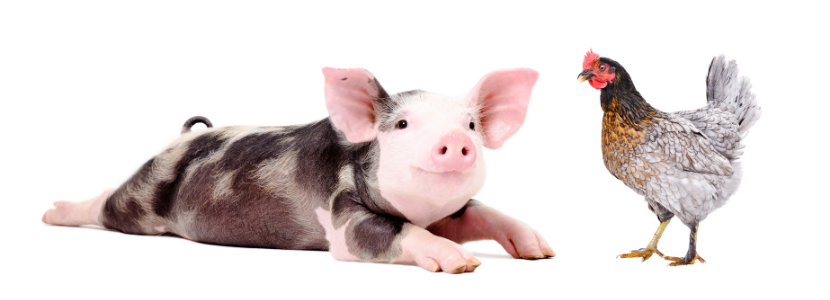 07 Mar 2022
07 Mar 2022
Feed processing and particle size play an important role in maximizing benefits within animal nutrition. Current food techcnologies only seek to enhance intake and efficiency in the use of nutrients. A finer size of feed particles allows the optimal nutrient use, and improves production animal yields.
There is a limit as to the fineness of particle size, as very fine particles adversely affect gut health due to an increased incidence of stomach ulcers in pigs and a dysfunction of the gizzard in birds.
As for the size of coarse particles, these increase acidification of the stomach and intestine, which can be beneficial in controlling enteric pathogens’ proliferation.
Advances in genetics have undoubtedly produced commercial lines of birds and pigs with a higher yield (growth, reproduction, etc.) with a lower feed supply.
![]() Feed processing and diet manufacturing have also evolved in such a way that diet composition, ingredient choices , and form have been refined to improve food consumption and efficiency.
Feed processing and diet manufacturing have also evolved in such a way that diet composition, ingredient choices , and form have been refined to improve food consumption and efficiency.
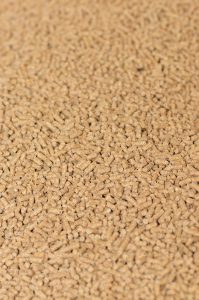
FEED PROCESSING
| The main function of feed is to provide nutrients that can be digested and used for productive and maintenance functions. |
To maximize yield, pig and poultry diets must contain the right balance of essential nutrients to meet the nutritional needs of the different production stages.
![]() Application in diet formulation requires an intimate knowledge of the animal, its daily nutritional needs, feed consumption potential, and understanding the selected foods’ capacity to provide the target nutrient at the lowest/best cost.
Application in diet formulation requires an intimate knowledge of the animal, its daily nutritional needs, feed consumption potential, and understanding the selected foods’ capacity to provide the target nutrient at the lowest/best cost.
Today, most pig and poultry feed is manufactured by employing a combination of food processing technologies. These include physical grinding with hammer and/or roller mills along with hydrothermal processing which includes granulation, expansion or extrusion.
![]() It is well known that processing parameters such as the degree of particle modification, temperature, pressure, duration and processing water determine the physical and chemical reactions between nutrients. As well as determining the adhesive properties on these particles’ surface.
It is well known that processing parameters such as the degree of particle modification, temperature, pressure, duration and processing water determine the physical and chemical reactions between nutrients. As well as determining the adhesive properties on these particles’ surface.
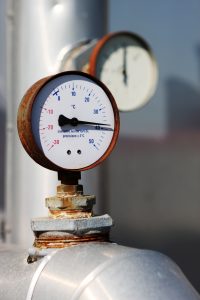
These attributes can directly and indirectly influence the impact of processed feed on the digestive tract’s microbiota. Therefore, having an impact on health, yield, and cost of animal feed.
PARTICLE SIZE
Pigs and poultry ar monogastric animals that rely heavily on their endogenous enzyme repertoire for their feeding. One of the most important factors that determines feed use in these animales, is particle size distribution. 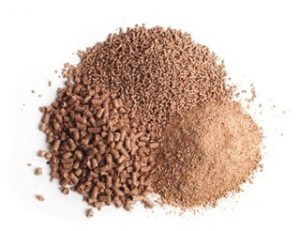
Particle size reduction always includes a grinding step with hammer o roller mills which facilitates further processing. In regards to animal performance, smaller particle size allows a better utilization of feed due to a greater specific surface area in feed particles. This allows better contact and itneraction with digestive enzymes. 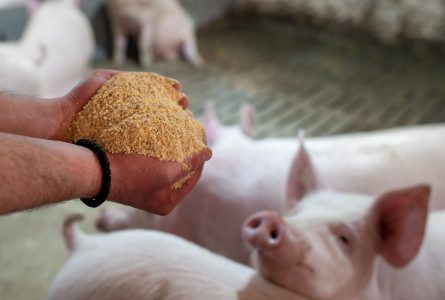
PARTICLE IMPACT ON THE INTESTINAL TRACT
PIGS
![]() In the case of pigs, gastric ulcers are one of the most important causes of sudden death and can cause great economic losses. The reasons for the occurrence of gastric epithelium alterations have not been clarified, but numerous reports indicate that the size of cereal particles and other food components are important risk factors.
In the case of pigs, gastric ulcers are one of the most important causes of sudden death and can cause great economic losses. The reasons for the occurrence of gastric epithelium alterations have not been clarified, but numerous reports indicate that the size of cereal particles and other food components are important risk factors.
The presence of large amounts of fine particles in pig feed leads to an increased incidence of stomach ulceration. In this context, finer particles tend to increase the fluidity of the stomach contents, which is associated with lesions of the “esophageal pars”.
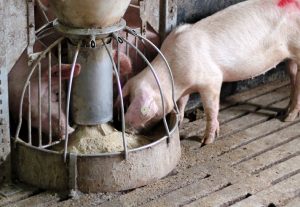
The proventriculus and gizzard are the true stomach compartments in birds. HCl and pepsinogen are secreted in the proventriculus and mixed with the contents of the gizzard through muscle movements.

![]() Due to the lack of teeth in birds, the gizzard has the important additional function of grinding feed material.
Due to the lack of teeth in birds, the gizzard has the important additional function of grinding feed material.
The lack of structural components in bird diets has been associated with dilated proventriculus and a non-functional gizzard, relating to feed utilization and gut health.
![]() It has also been reported that the volume of gizzards can increase when structural components such as whole or coarsely ground cereals are added to the diet. Such increase can be twice the original size.
It has also been reported that the volume of gizzards can increase when structural components such as whole or coarsely ground cereals are added to the diet. Such increase can be twice the original size.
Due to the grinding in the gizzard, the particles that reach the small intestine have no relation to the size of the original food particles. Therefore, the impact of the size of the food particles on the physiology of the small intestine and the cecum is minimal.
IMPACT ON INTESTINAL MICROBIOTA
PIGS
The distribution of food particle size has been associated with a strong influence on the presence of enteric pathogenic bacteria. Data shows that thick particle sized food generates a greater pH decrease in stomach contents compared to fine sized particles.
Studies show that pigs fed coarse crushes had much higher gastric microbial fermentation than pigs fed finer diets. Associated with: slower gastric passage rate, higher gastric dry matter content and consistency.
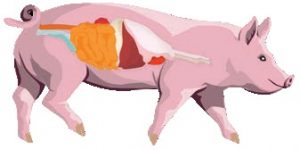
With a low gastric pH, protein digestion and populations of beneficial bacteria (lactobacilli) are maximized and harmful bacteria such as enterotoxigenic E. coli are inhibited.
![]() Feed particle size not only affects gastric ecology, but also other parts of the GI tract, especially that of the large intestine.
Feed particle size not only affects gastric ecology, but also other parts of the GI tract, especially that of the large intestine.
POULTRY
As in pigs, the gizzard in birds is considered an important barrier that helps prevent pathogenic bacteria from entering the intestinal tract. Bacteria that enter the intestinal tract through food have a higher chance of being suppressed in a highly acidic environment.
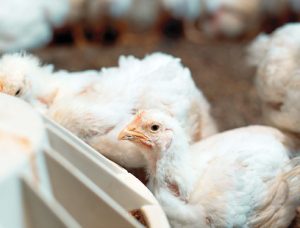
The size of food particles can affect the physiological and morphological characteristics of the gastrointestinal tract and therefore the microbial state.
HYDROTHERMAL PROCESSING (HTP)
Common hydrothermal (HTP) processes in feed manufacturing include:
The principle behind these processes is the agglomeration of small particles into larger particles by means of mechanical compression combined with moisture application, heat, shear forces and vapor pressure.
IMPACT OF MICROBIAL LOAD
Most salmonella and coliforms can be removed with granulation at temperatures above 80 °C. On the other hand spore-forming bacteria are resistant to the granulation process at temperatures as high as 90 °C.

![]() The most crucial stage for recontamination of the processed food is during the cooling stage. Due to the large volume of air that passes through the coolers and the dust collected at this point, there is a greater probability for contamination to occur.
The most crucial stage for recontamination of the processed food is during the cooling stage. Due to the large volume of air that passes through the coolers and the dust collected at this point, there is a greater probability for contamination to occur.
MICROBIAL ACTIVITY
The diversity of the microbiota in an intestinal section partly reflects the type of nutrient substrates in that area. The gastrointestinal microbiota gets most of its carbon and energy from luminal compounds (dietary and/or endogenous), which are resistant to digestive fluids or they are so slowly absorbed by the host that bacteria can successfully compete for them.
![]() Since bacterial species differ in their substrate preferences and growth requirements, the chemical composition and structure of intake largely determine the distribution of bacterial species within the gastrointestinal tract.
Since bacterial species differ in their substrate preferences and growth requirements, the chemical composition and structure of intake largely determine the distribution of bacterial species within the gastrointestinal tract.
| As mentioned before, HTP improves nutrient digestibility. |
PIGS
Studies revealed that heat treatment of cereals for piglets (corn and barley) and steam granulation increased the yield of post-weaning growth and changed intestinal fermentation profiles. Authors explained that granulated diets stimulate the secretion of mucins which facilitate the colonization of Salmonella.
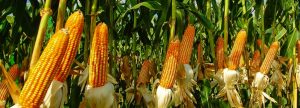
POULTRY
An in vivo experiment showed that birds fed granulated diets had significantly higher concentrations of Salmonella enterica serovar Typhimurium DT12 in their gastrointestinal tract compared to those fed with meal (“mash”)
In fact, studies have shown that feed granulation increases the incidence of Salmonella in the gizzard and ceccum content of growing broilers. Which demonstrates that the gizzard can be an important critical control point to reduce Salmonella contamination in broilers.

THE FUTURE: OPTIMAL FEED PROCESSING
![]() The benefits of feed processing in economic terms and in regards to animal performance are unquestionnable.
The benefits of feed processing in economic terms and in regards to animal performance are unquestionnable.
Concerns related to aspects such as granule quality, nutrient digestibility, protein denaturation and milling efficiency will continue to stimulate innovation in feed manufacturing. The possibilities of decreasing the intensity of particle crushing during granulation, by varying parameters of the granulation process, are very limited.

Therefore, with the evolution of pig and poultry production practices, food processing regimes are no longer appreciated only in terms of optimizing nutrient utilization, but also in terms of their impact on:
Summary excerpt of the article : Frontiers in veterinary science. Role of Feed Processing on Gut Health and Function in Pigs and Poultry: Conundrum of Optimal Particle Size and Hydrothermal Regimens.
Subscribe now to the technical magazine of animal nutrition
AUTHORS

Nutritional Interventions to Improve Fertility in Male Broiler Breeders
Edgar Oviedo
The Use of Organic Acids in Poultry: A Natural Path to Health and Productivity
M. Naeem
Synergistic Benefits of Prebiotics and Probiotics in Poultry, Swine, and Cattle
Gustavo Adolfo Quintana-Ospina
Hybrid Rye Potential in Laying Hen Feed Rations
Gwendolyn Jones
A day in the life of phosphorus in pigs: Part I
Rafael Duran Giménez-Rico
Use of enzymes in diets for ruminants
Braulio de la Calle Campos
Minerals and Hoof Health in the Pregnant Sow
Juan Gabriel Espino
Impact of Oxidized Fats on Swine Reproduction and Offspring
Maria Alejandra Perez Alvarado